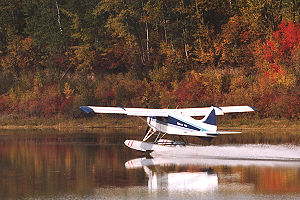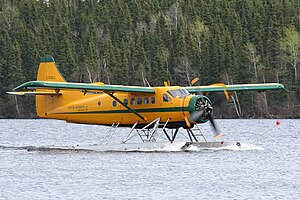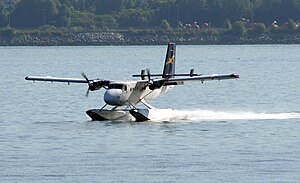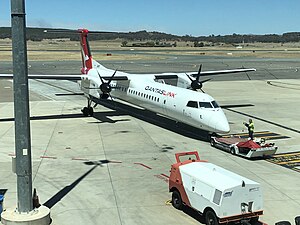Viking Air: Difference between revisions
George Swan (talk | contribs) (first draft) |
mNo edit summary |
||
| (8 intermediate revisions by 2 users not shown) | |||
| Line 1: | Line 1: | ||
'''Viking Air''' was the former name of a Canadian manufacturer, now known as [[De Havilland Canada]]. | {{subpages}} | ||
[[File:Fort mcmurray float plane at syne.jpg | thumb | Its large high wing, and rugged powerful engine were two factors that made the Beaver a successful bush-plane.]] | |||
[[File:PolishOtter.jpg | thumb | The DHC-3 Otter was originally powered by a single piston engine.]] | |||
'''Viking Air''' was the former name of a Canadian aircraft manufacturer, now known as [[De Havilland Canada]].<ref name=wingsmagazine2022-02-04/> | |||
The original manufacturer known as De Havilland Canada was a successful spinoff of the UK aircraft manufacturer [[De Havilland]]. During [[World War | The original manufacturer known as De Havilland Canada, founded in 1928, was a successful spinoff of the UK aircraft manufacturer [[De Havilland]].<ref name=wingsmagazine2022-02-04/> During [[World War II]] it manufactured planes, designed by the parent company, in [[Canada]]. After World War II the Canadian firm designed and built a range of highly regarded planes, including rugged [[bush planes]], designed for [[Short takeoff and landing]] on meadows, on skis, or on pontoons. | ||
De Havilland Canada was eventually acquired by [[Bombardier]], an even larger Canadian manufacturer. | De Havilland Canada was eventually acquired by [[Bombardier]], an even larger Canadian manufacturer. | ||
| Line 9: | Line 12: | ||
In the late 2010s Bombardier shaky finances provided Viking Air an opportunity to purchase the intellectual property rights to other popular legacy aircraft designed by De Havilland Canada. | In the late 2010s Bombardier shaky finances provided Viking Air an opportunity to purchase the intellectual property rights to other popular legacy aircraft designed by De Havilland Canada. | ||
In 2022 Viking Air was able to buy the name De Havilland Canada, from Bombardier, and manufacture | In 2022 Viking Air's parent company, [[Longview Aviation Capitol]], was able to buy the name De Havilland Canada, from Bombardier, and manufacture aircraft under the De Havilland Canada name.<ref name=wingsmagazine2022-02-04/> | ||
==De Havilland Canada bush-planes== | ==De Havilland Canada bush-planes== | ||
[[File:Vancouver to Victoria. West Coast Air De Havilland DHC-6 Twin Otter floatplane.jpg | left | thumb]] | |||
The [[DHC Beaver]], [[DHC Otter]], and [[DHC Twin Otter]], were among the most highly regarded bush planes. The Twin Otter, when configured to carry passengers, had a capacity of 20. The firms next passenger aircraft was the [[DHC-7]], also known as the Dash-7. It was a four-engined plane, with a large wing, also capable of carrying passengers to and from short, poorly-finished airfields. But it carried approximately twice as many passengers as the Twin Otter, carried them with more comfort, and as sealed, so it could fly at the same altitude as other airliners. | The [[DHC Beaver]], [[DHC Otter]], and [[DHC Twin Otter]], were among the most highly regarded bush planes. The Twin Otter, when configured to carry passengers, had a capacity of 20. The firms next passenger aircraft was the [[DHC-7]], also known as the Dash-7. It was a four-engined plane, with a large wing, also capable of carrying passengers to and from short, poorly-finished airfields. But it carried approximately twice as many passengers as the Twin Otter, carried them with more comfort, and as sealed, so it could fly at the same altitude as other airliners. | ||
==De Havilland Canada STOL airliners== | ==De Havilland Canada STOL airliners== | ||
[[File:De Havilland Canada DHC-7-102 Dash 7, Tyrolean Airways AN2326392.jpg | left | thumb | The Dash-7 with its high, large wing, bears a resemblance to the early Twin Otter. Note the four turboprops that give it admirable STOL capability.]] | |||
[[File:QantasLink (Sunstate Airlines) Dash 8 VH-QOS.jpg | thumb | The Dash-8's smaller wing, with only a single pair of engines, makes it more fuel efficient, but requires sacrificing STOL capability.]] | |||
The slightly larger [[Dash-8]] was slightly larger than the Dash-7, and traded some of the STOL capability for more efficient flying between finished airfields. | The slightly larger [[Dash-8]] was slightly larger than the Dash-7, and traded some of the STOL capability for more efficient flying between finished airfields. | ||
| Line 28: | Line 33: | ||
The [[DHC-515]] is a modernized water bomber, designed to use 21st century avionics, and to fill other roles, like maritime patrol and surviellance, and [[search and rescue]]. Unlike the earlier planes, it is well equipped to fly at night. And the other roles it can fill mean the planes can be used during the months when firefighting aircraft are not required. | The [[DHC-515]] is a modernized water bomber, designed to use 21st century avionics, and to fill other roles, like maritime patrol and surviellance, and [[search and rescue]]. Unlike the earlier planes, it is well equipped to fly at night. And the other roles it can fill mean the planes can be used during the months when firefighting aircraft are not required. | ||
==References== | |||
<!-- | |||
| archivedate = | url-status = live | archiveurl = | |||
| url-status = live | archivedate = | archiveurl = | |||
| url-status = dead | archivedate = | archiveurl = | |||
--> | |||
{{Reflist|refs= | |||
{{cite news | |||
| url = | |||
| title = | |||
| work = | |||
| author = | |||
| date = | |||
| page = | |||
| location = | |||
| isbn = | |||
| language = | |||
| trans-title = | |||
| archiveurl = | |||
| archivedate = | |||
| accessdate = 2022-04-05 | |||
| url-status = live | |||
| quote = | |||
}} | |||
</ref> | |||
{{cite news | |||
| url = | |||
| title = | |||
| work = | |||
| author = | |||
| date = | |||
| page = | |||
| location = | |||
| isbn = | |||
| language = | |||
| trans-title = | |||
| archiveurl = | |||
| archivedate = | |||
| accessdate = 2022-04-05 | |||
| url-status = live | |||
| quote = | |||
}} | |||
</ref> | |||
{{cite news | |||
| url = | |||
| title = | |||
| work = | |||
| author = | |||
| date = | |||
| page = | |||
| location = | |||
| isbn = | |||
| language = | |||
| trans-title = | |||
| archiveurl = | |||
| archivedate = | |||
| accessdate = 2022-04-05 | |||
| url-status = live | |||
| quote = | |||
}} | |||
</ref> | |||
<ref name=wingsmagazine2022-02-04> | |||
{{cite news | |||
| url = https://www.wingsmagazine.com/longview-consolidates-companies-under-de-havilland-appoints-chafe-as-ceo/ | |||
| title = Longview consolidates companies under De Havilland, appoints Chafe as CEO | |||
| work = [[Wings magazine]] | |||
| date = 2022-02-04 | |||
| archiveurl = https://web.archive.org/web/20220218163339/https://www.wingsmagazine.com/longview-consolidates-companies-under-de-havilland-appoints-chafe-as-ceo/ | |||
| archivedate = 2022-02-18 | |||
| accessdate = 2022-04-05 | |||
| url-status = live | |||
| quote = Longview Aviation Capital on Feb. 2 announced De Havilland Aircraft of Canada Limited will become the operating brand for the companies currently operating as Longview Aviation, Viking Air, Pacific Sky Training and De Havilland Canada. Which combined currently support more than 1,000 aerospace jobs across Canada. | |||
}} | |||
</ref> | |||
}} | |||
[[Category:Suggestion Bot Tag]] | |||
Latest revision as of 07:01, 5 November 2024
Viking Air was the former name of a Canadian aircraft manufacturer, now known as De Havilland Canada.[1]
The original manufacturer known as De Havilland Canada, founded in 1928, was a successful spinoff of the UK aircraft manufacturer De Havilland.[1] During World War II it manufactured planes, designed by the parent company, in Canada. After World War II the Canadian firm designed and built a range of highly regarded planes, including rugged bush planes, designed for Short takeoff and landing on meadows, on skis, or on pontoons.
De Havilland Canada was eventually acquired by Bombardier, an even larger Canadian manufacturer.
When Bombardier focussed on building newer planes, and closed its production lines for the older but still popular De Havilland Aircraft they allowed Viking Air to build spare parts to keep those legacy aircraft flying. In the 2010 Bombardier sold Viking Air all its intellectual property rights to the Twin Otter, and Viking Air changed from being solely a manufacturer of parts to a manufacturer of aircraft, as it started to build new Twin Otters, with more modern avionics.
In the late 2010s Bombardier shaky finances provided Viking Air an opportunity to purchase the intellectual property rights to other popular legacy aircraft designed by De Havilland Canada.
In 2022 Viking Air's parent company, Longview Aviation Capitol, was able to buy the name De Havilland Canada, from Bombardier, and manufacture aircraft under the De Havilland Canada name.[1]
De Havilland Canada bush-planes
The DHC Beaver, DHC Otter, and DHC Twin Otter, were among the most highly regarded bush planes. The Twin Otter, when configured to carry passengers, had a capacity of 20. The firms next passenger aircraft was the DHC-7, also known as the Dash-7. It was a four-engined plane, with a large wing, also capable of carrying passengers to and from short, poorly-finished airfields. But it carried approximately twice as many passengers as the Twin Otter, carried them with more comfort, and as sealed, so it could fly at the same altitude as other airliners.
De Havilland Canada STOL airliners
The slightly larger Dash-8 was slightly larger than the Dash-7, and traded some of the STOL capability for more efficient flying between finished airfields.
De Havilland Canada water bombers
De Havilland Canada also developed the DHC-215, the world's first purpose-built water-bomber. It was introduced in 1969, and a total of 95 airframes were sold.
By 1993 De Havilland had been acquired by Bombardier. Nevertheless the updated follow-on to the 215 was called the DHC-415. Approximately 120 airframes were sold.
The DHC-515
The DHC-515 is a modernized water bomber, designed to use 21st century avionics, and to fill other roles, like maritime patrol and surviellance, and search and rescue. Unlike the earlier planes, it is well equipped to fly at night. And the other roles it can fill mean the planes can be used during the months when firefighting aircraft are not required.
References
- ↑ 1.0 1.1 1.2 Longview consolidates companies under De Havilland, appoints Chafe as CEO, Wings magazine, 2022-02-04. Retrieved on 2022-04-05. “Longview Aviation Capital on Feb. 2 announced De Havilland Aircraft of Canada Limited will become the operating brand for the companies currently operating as Longview Aviation, Viking Air, Pacific Sky Training and De Havilland Canada. Which combined currently support more than 1,000 aerospace jobs across Canada.”




